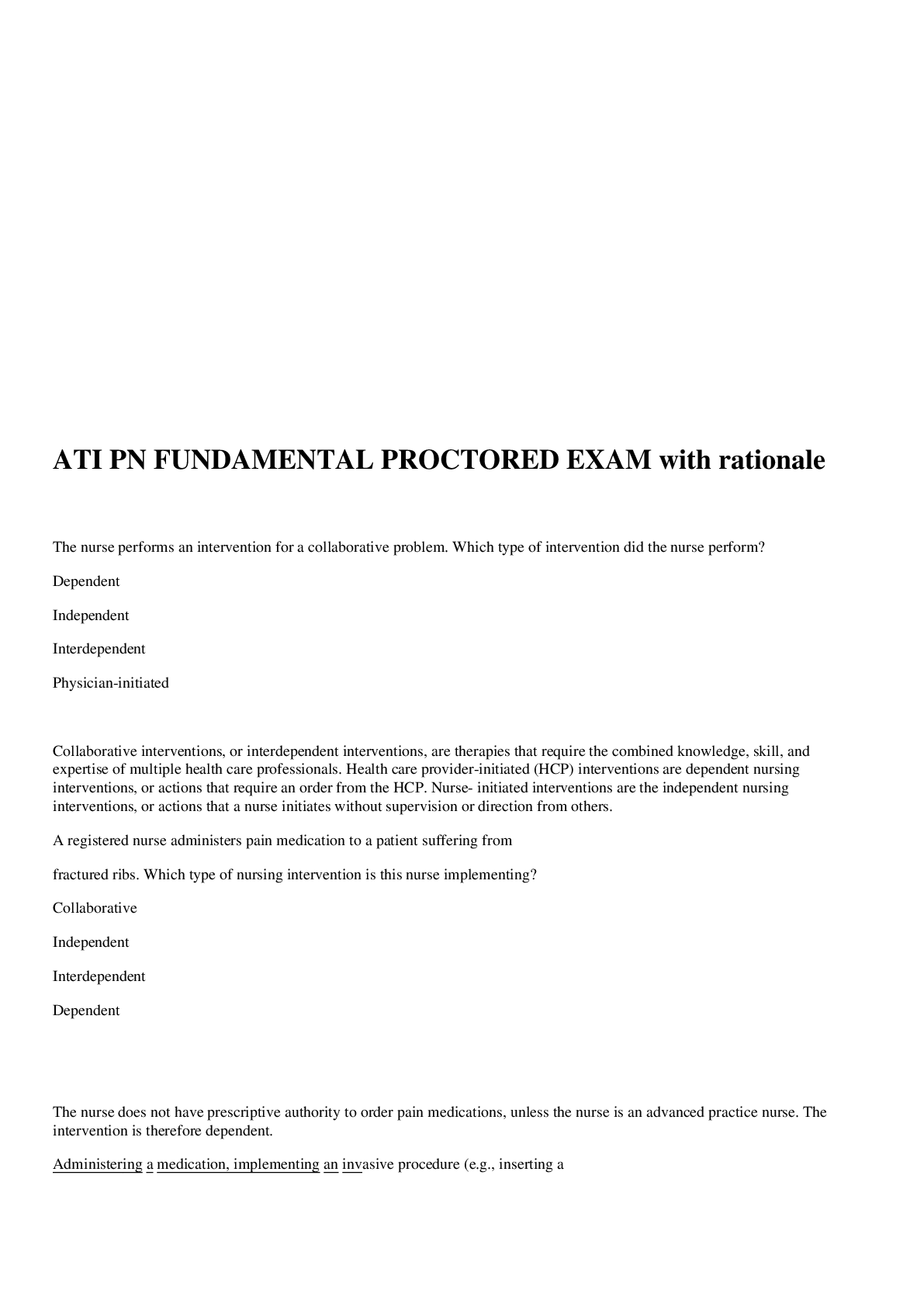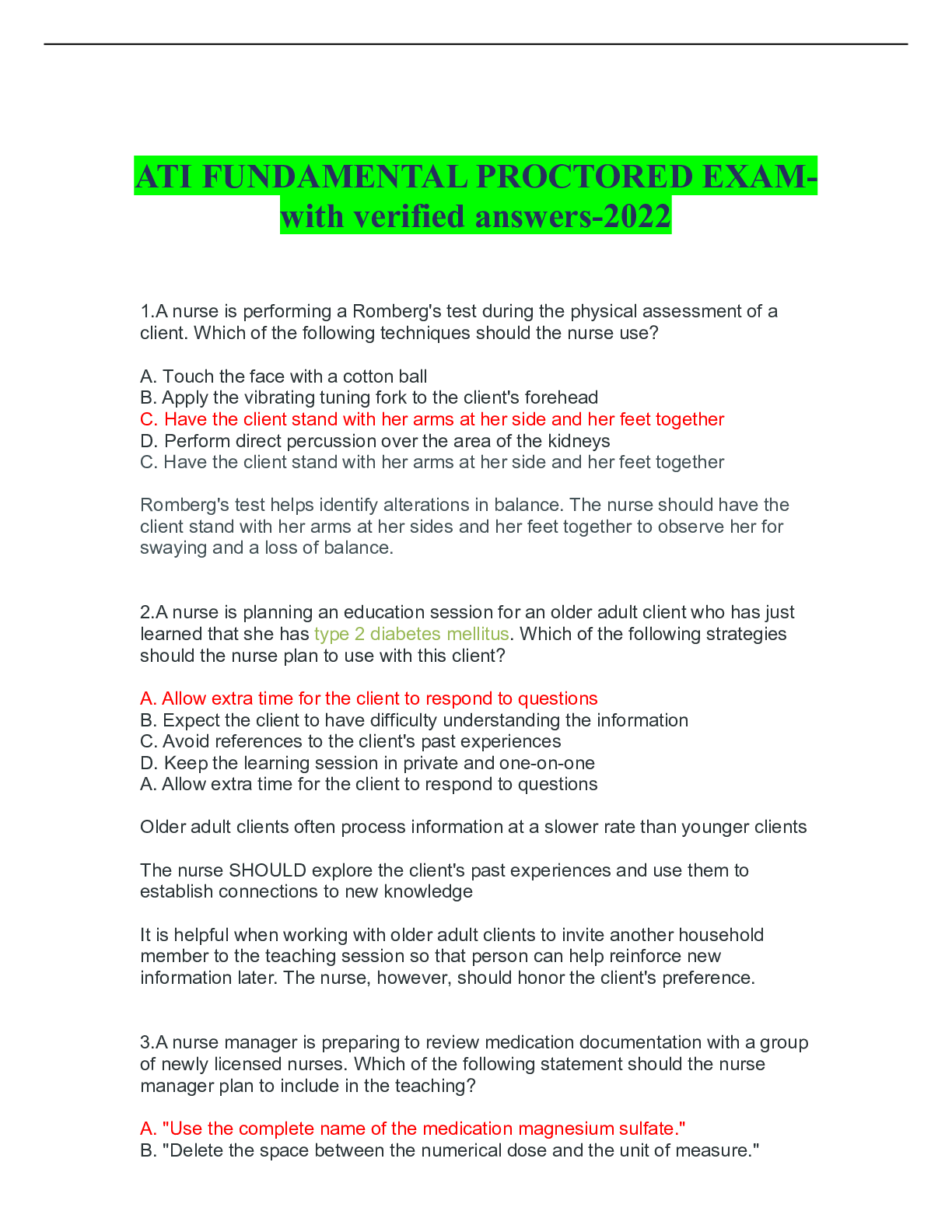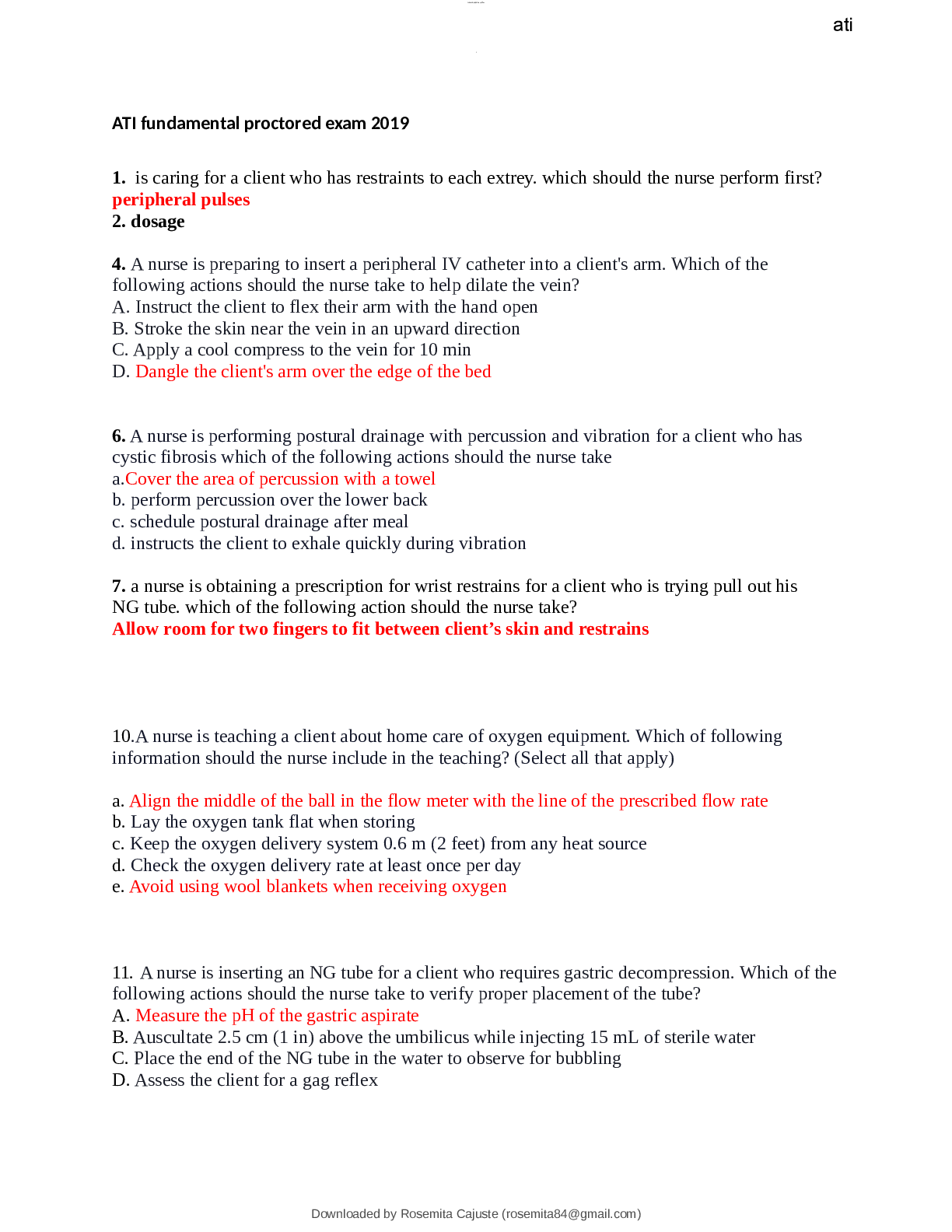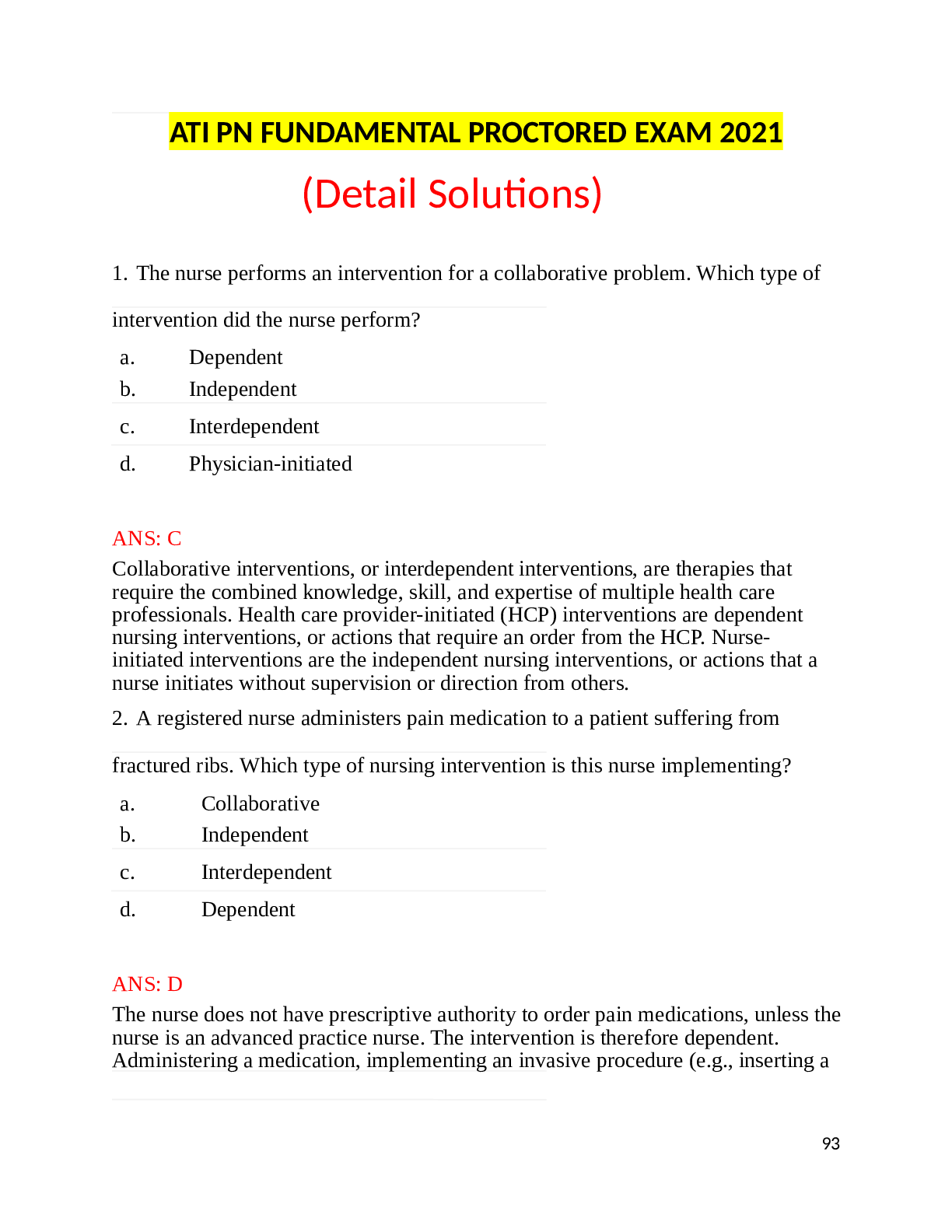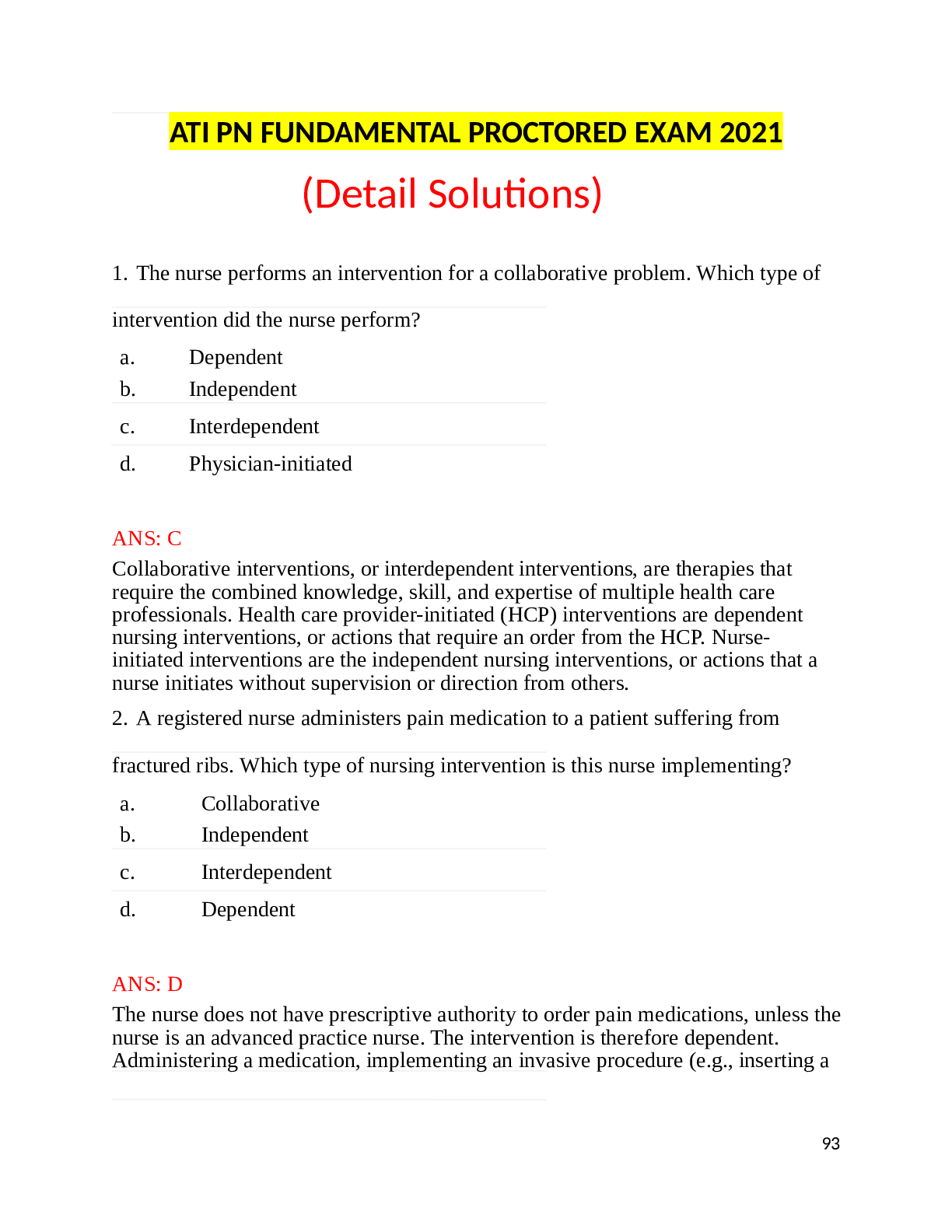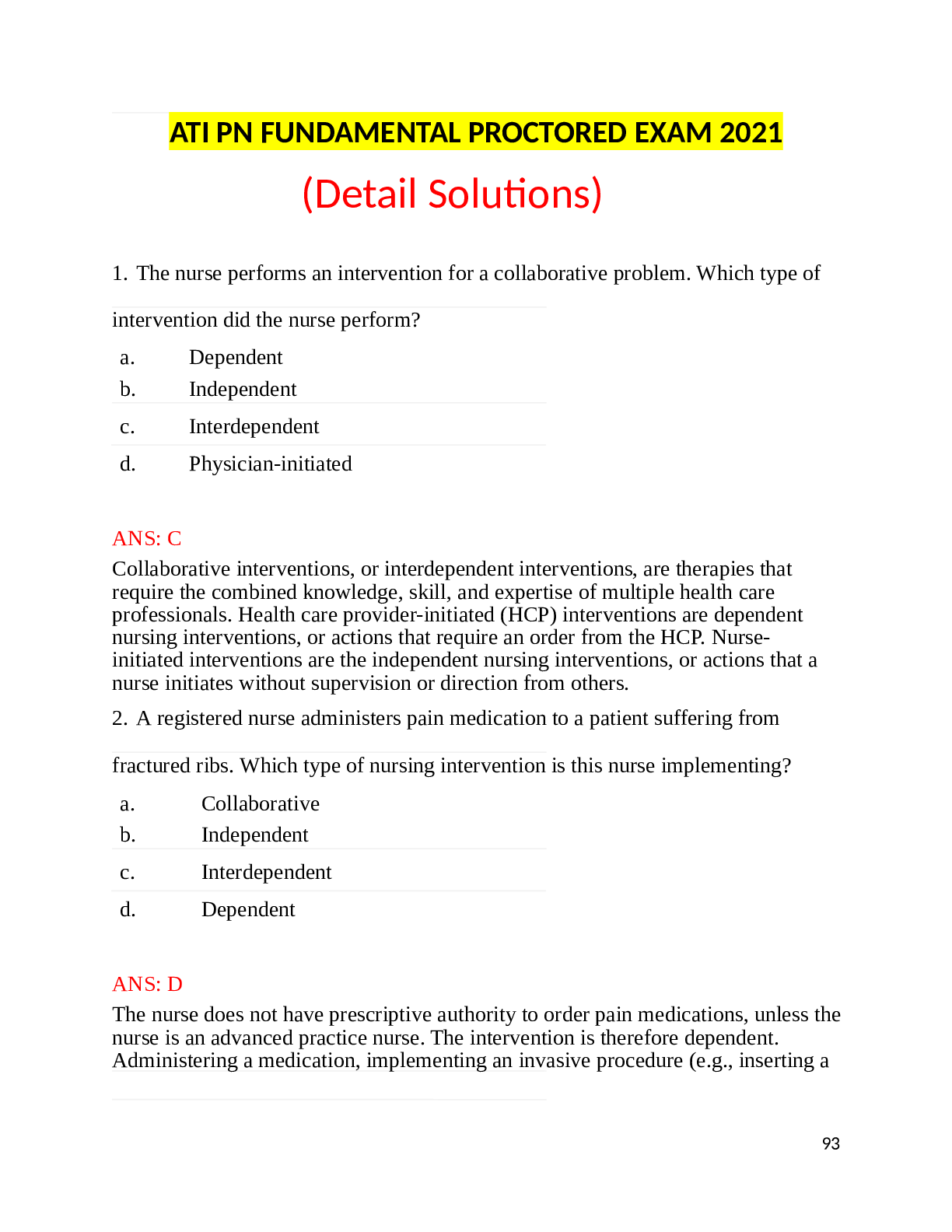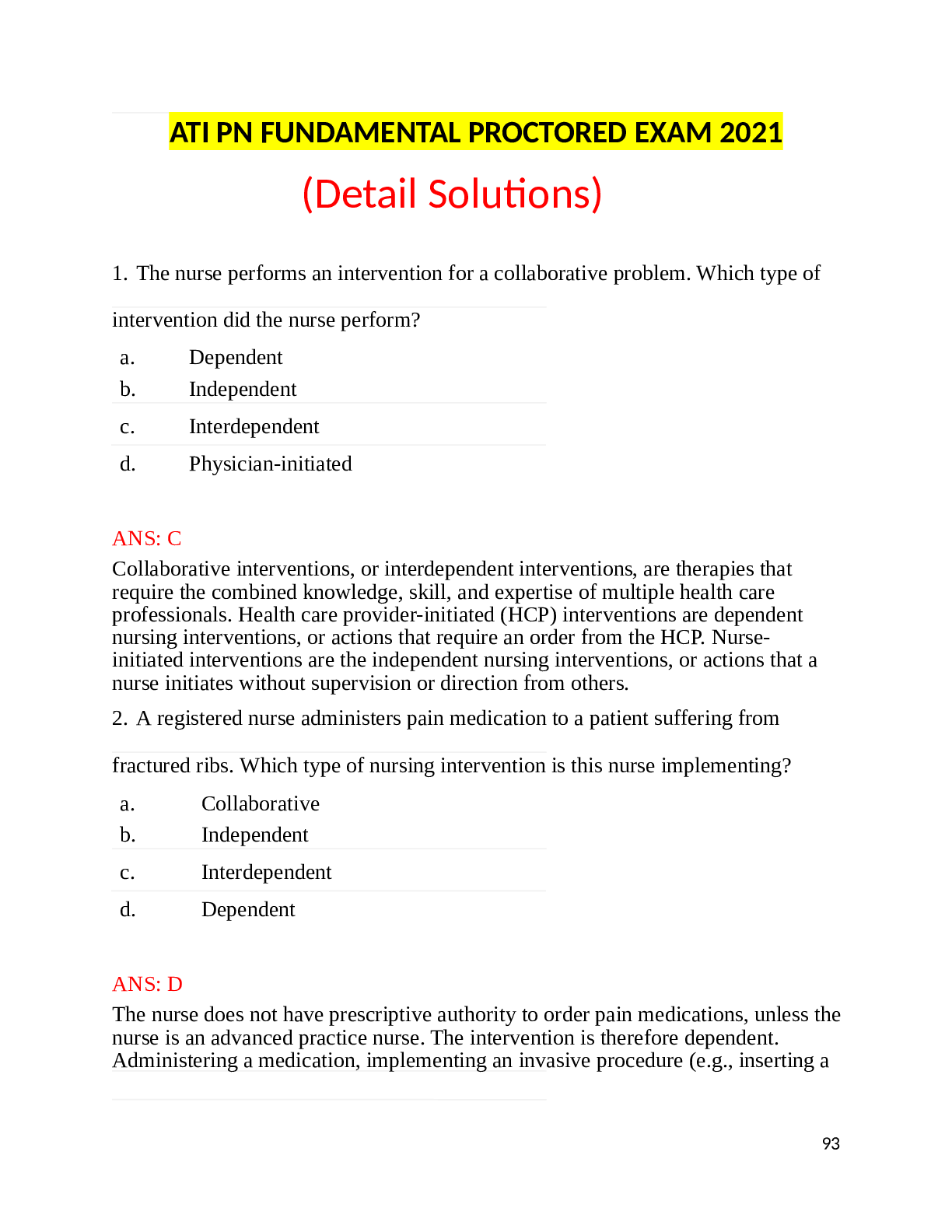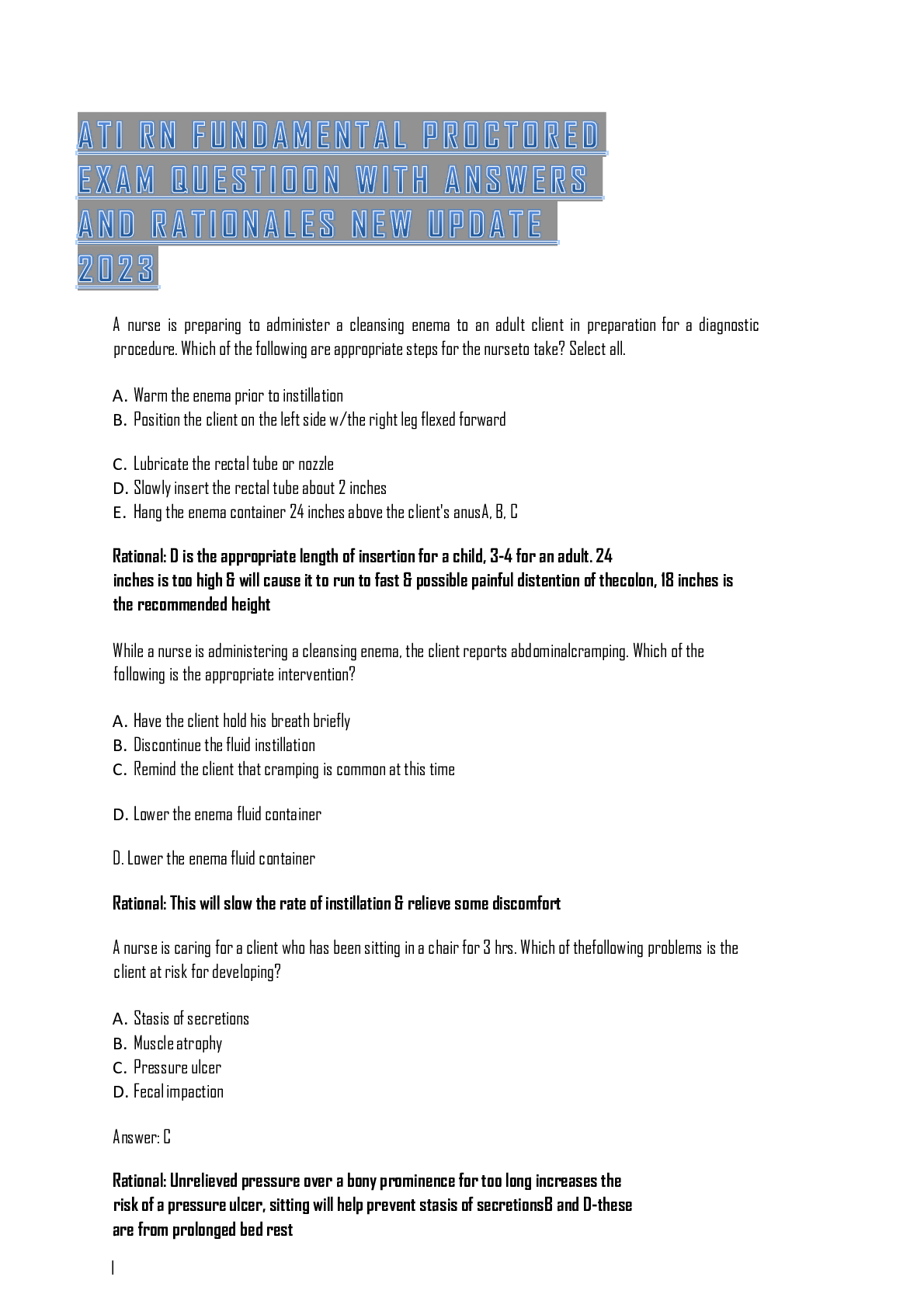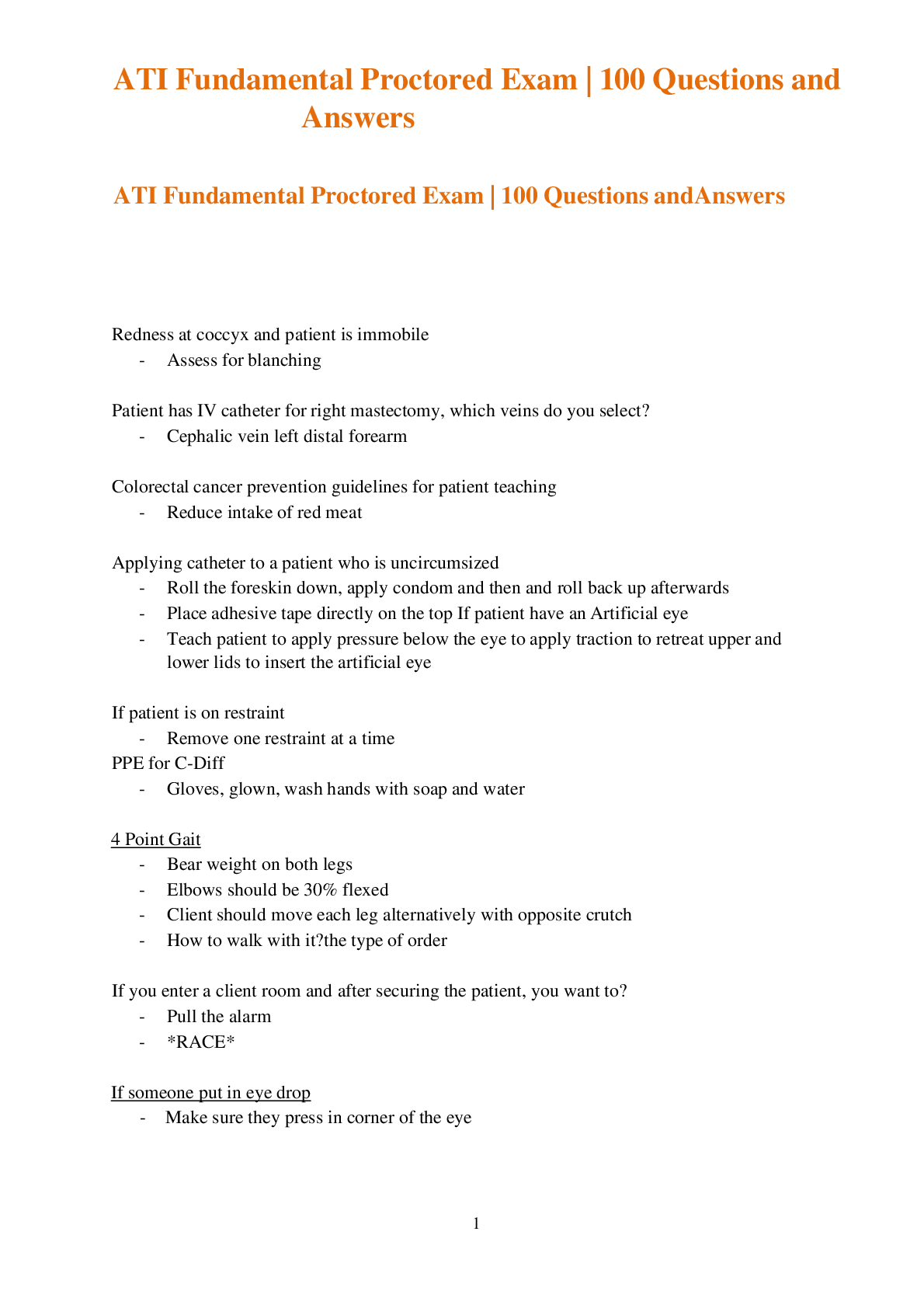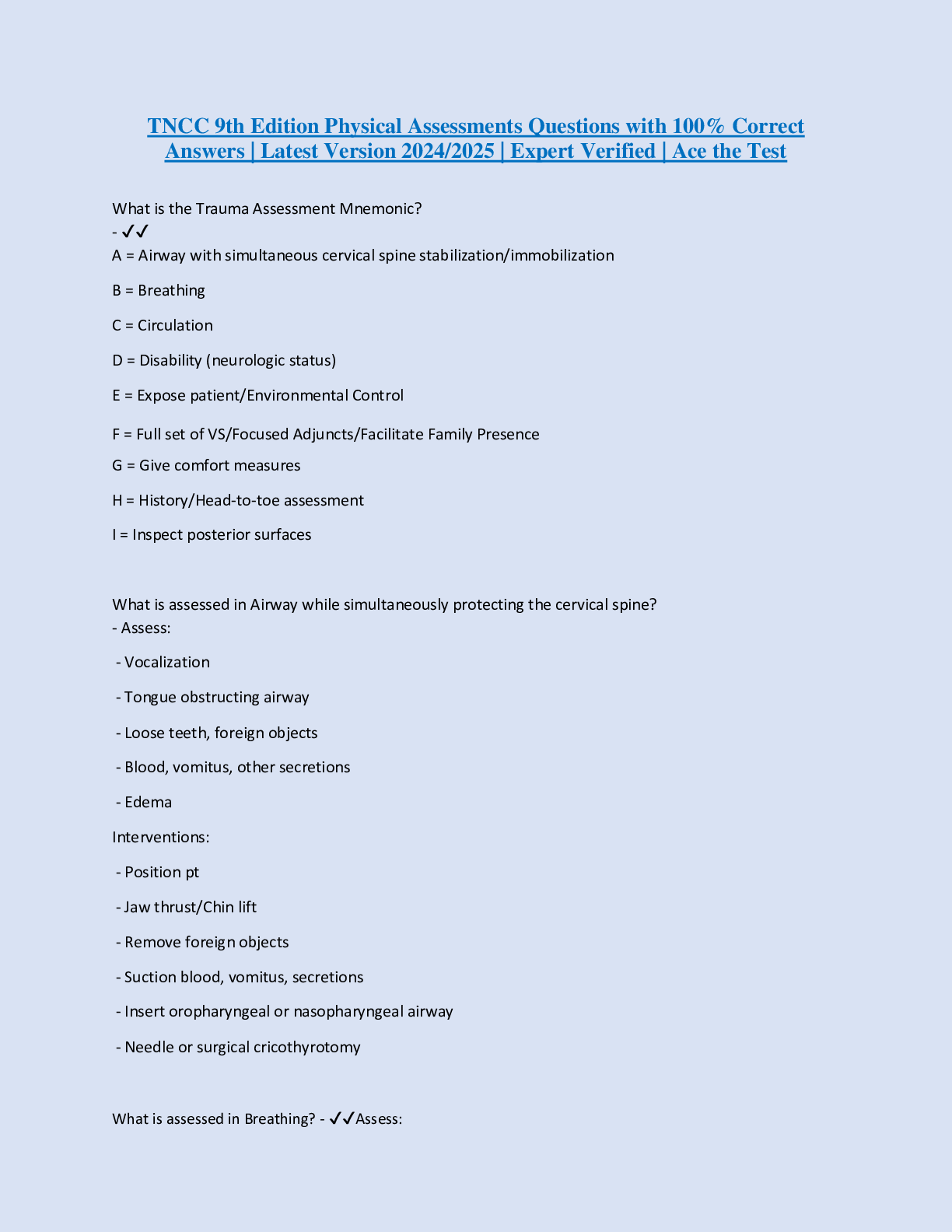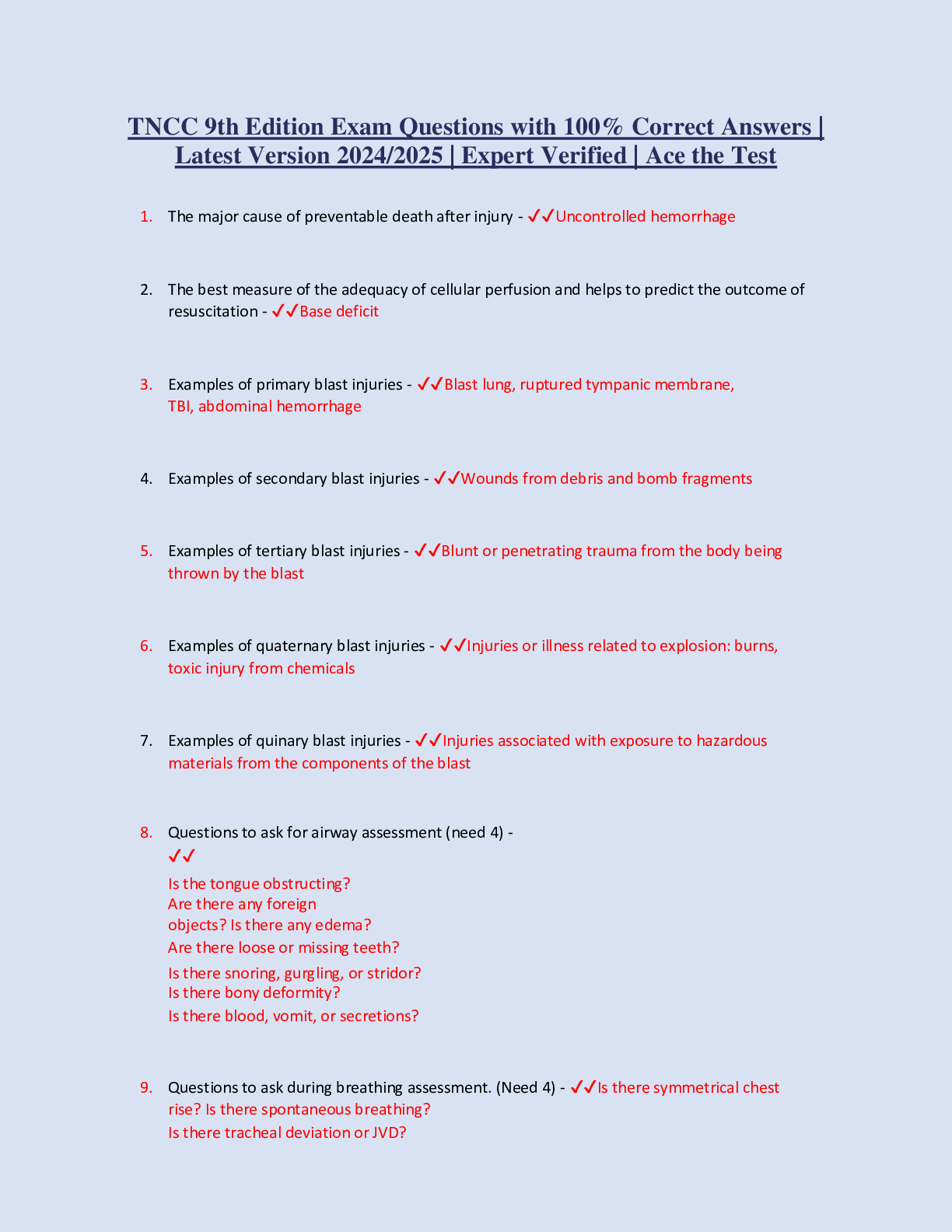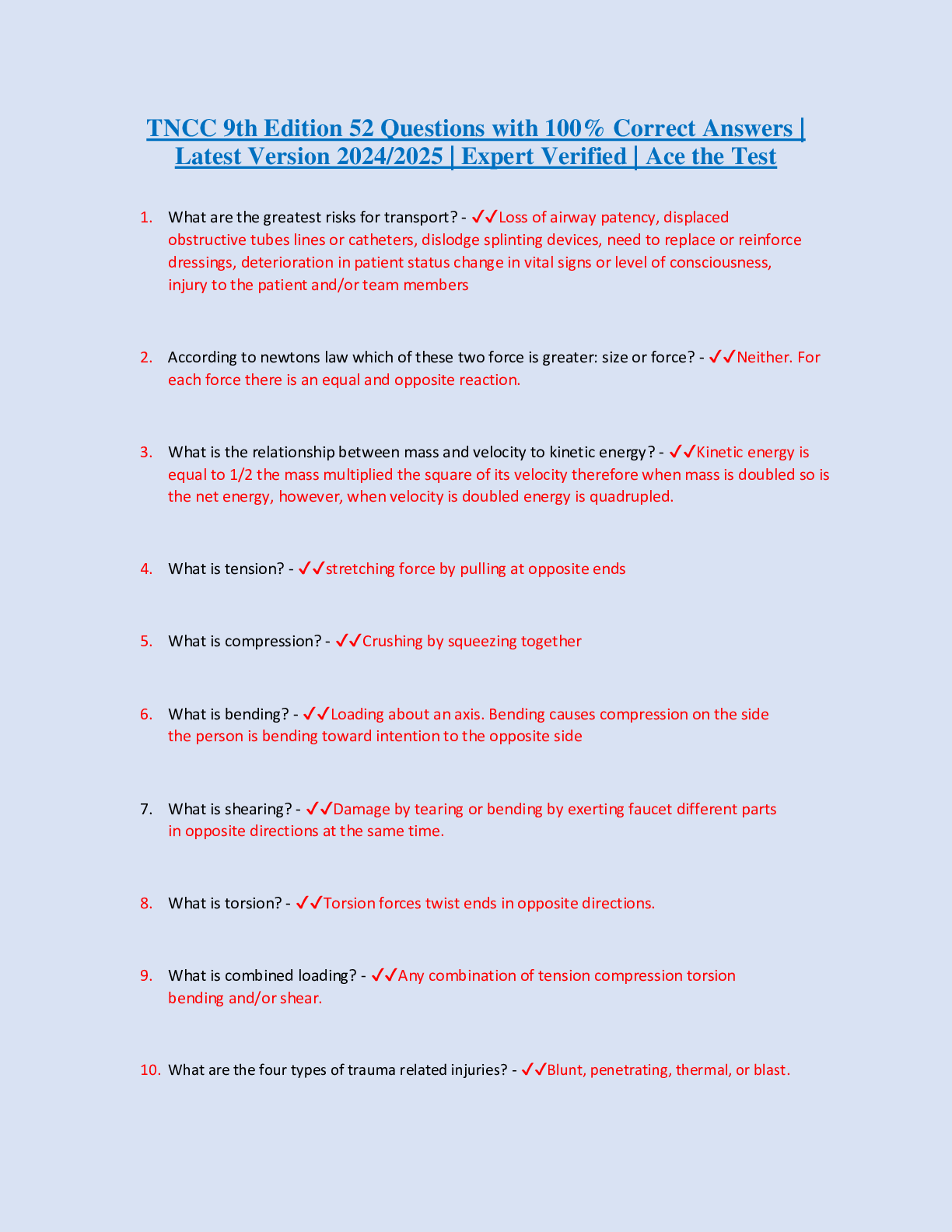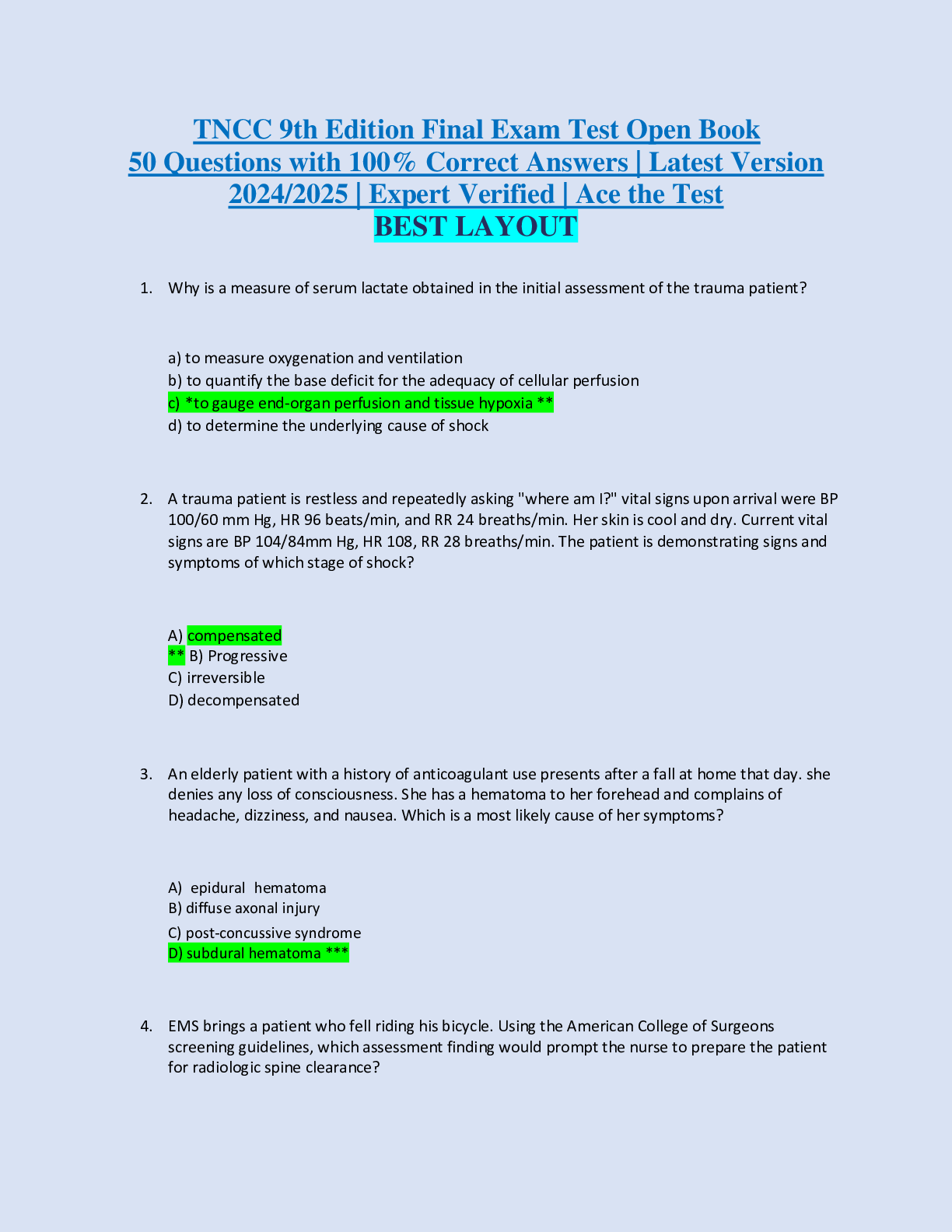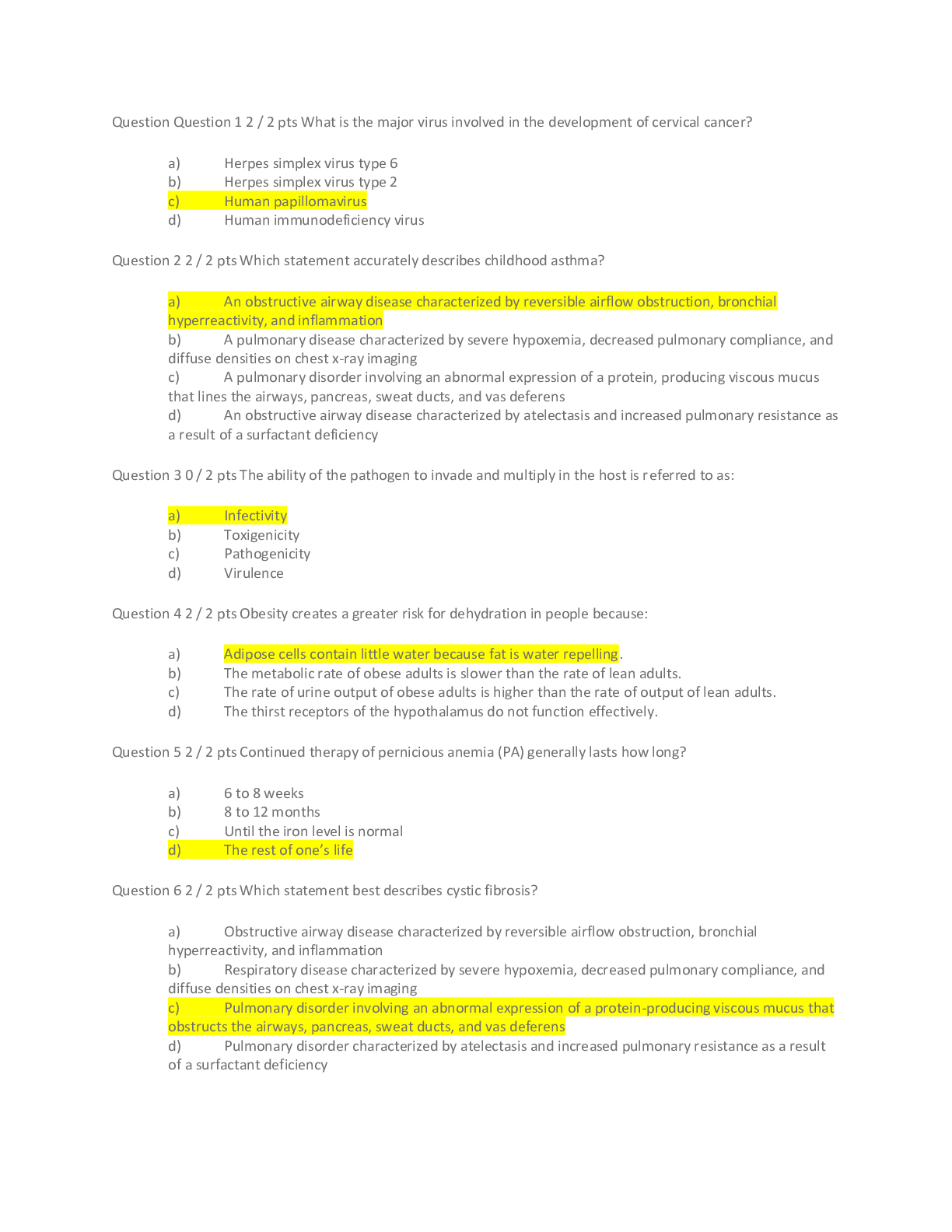ATI PN FUNDAMENTAL PROCTORED EXAM 2021.
Document Content and Description Below
ATI PN FUNDAMENTAL PROCTORED EXAM 2021 (Detail Solutions) 1. The nurse performs an intervention for a collaborative problem. Which type of intervention did the nurse perform? a. Dependent b. Inde... pendent c. Interdependent d. Physician-initiated ANS: C Collaborative interventions, or interdependent interventions, are therapies that require the combined knowledge, skill, and expertise of multiple health care professionals. Health care provider-initiated (HCP) interventions are dependent nursing interventions, or actions that require an order from the HCP. Nurseinitiated interventions are the independent nursing interventions, or actions that a nurse initiates without supervision or direction from others. 2. A registered nurse administers pain medication to a patient suffering from fractured ribs. Which type of nursing intervention is this nurse implementing? a. Collaborative b. Independent c. Interdependent d. Dependent ANS: D The nurse does not have prescriptive authority to order pain medications, unless the nurse is an advanced practice nurse. The intervention is therefore dependent. Administering a medication, implementing an invasive procedure (e.g., inserting a 93 Foley catheter, starting an intravenous [IV] infusion), and preparing a patient for diagnostic tests are examples of health care provider-initiated interventions. A collaborative, or an interdependent, intervention involves therapies that require combined knowledge, skill, and expertise from multiple health care professionals. Nurse-initiated interventions are the independent nursing interventions, or actions that a nurse initiates without supervision or direction from others. 3. Which action indicates the nurse is using a PICOT question to improve care for a patient? a. Practices nursing based on the evidence presented in court b. Implements interventions based on scientific research c. Uses standardized care plans for all patients. d. Plans care based on tradition ANS: B The best answer is implementing interventions based on scientific research. Using results of a literature search to a PICOT question can help a nurse decide which interventions to use. Practicing based on evidence presented in court is incorrect. Practice is based on current research. Using standardized care plans may be one example of evidence-based practice, but it is not used on all patients. The nurse must be careful in using standardized care plans to ensure that each patient’s plan of care is still individualized. Planning care based on tradition is incorrect because nursing care should be based on current research. 4. A nurse is developing a care plan. Which intervention is most appropriate for the nursing diagnostic statement Risk for loneliness related to impaired verbal communication? a. Provide the patient with a writing board each shift. b. Obtain an interpreter for the patient as soon as possible. c. Assist the patient in performing swallowing exercises each shift. Ask the family to provide a sitter to remain with the patient at all d. times. 93 ANS: A Choose interventions to alter the etiological (related to) factor or causes of the diagnosis. If the etiology is impaired verbal communication, then the nurse should choose an intervention that will address the problem. Providing the patient with a writing board will allow the patient to communicate by writing because the patient is unable to communicate verbally at this time. Obtaining an interpreter might be an appropriate intervention if the patient spoke a foreign language. Assisting with swallowing exercises will help the patient with swallowing, which is a different etiology than impaired verbal communication. Asking the family to provide a sitter at all times is many times unrealistic and does not relate to the impaired verbal communication; the goal would relate to the loneliness. 5. A nurse is completing a care plan. Which intervention is most appropriate for the nursing diagnostic statement Impaired skin integrity related to shearing forces? a. Administer pain medication every 4 hours as needed. b. Turn the patient every 2 hours, even hours. c. Monitor vital signs, especially rhythm. d. Keep the bed side rails up at all times. ANS: B The most appropriate intervention for the diagnosis of Impaired skin integrity is to turn the patient. Choose interventions to alter the etiological (related to) factor or causes of the diagnosis. The other options do not directly address the shearing forces. The patient may need pain medication, but Acute pain would be another nursing diagnosis. Monitoring vital signs does not have when or how often these should be done. Keeping the side rails up addresses safety, not skin integrity. 6. A patient has reduced muscle strength following a left-sided stroke and is at risk for falling. Which intervention is most appropriate for the nursing diagnostic statement Risk for falls? a. Keep all side rails down at all times. b. Encourage patient to remain in bed most of the shift. 93 c. Place patient in room away from the nurses’ station if possible. d. Assist patient into and out of bed every 4 hours or as tolerated. ANS: D Risk for falls is a risk (potential) nursing diagnosis; therefore, the nurse needs to implement actions that will prevent a fall. Assisting the patient into and out of bed is the most appropriate intervention to prevent the patient from falling. Encouraging activity builds muscle strength, and helping the patient with transfers ensures patient safety. Encouraging the patient to stay in bed will not promote muscle strength. Decreased muscle strength is the risk factor placing the patient in jeopardy of falling. The side rails should be up, not down, according to agency policy. This will remind the patient to ask for help to get up and will keep the patient from rolling out of bed. The patient should be placed near the nurses’ station, so a staff member can quickly get to the room and assist the patient if necessary. 7. Which action will the nurse take after the plan of care for a patient is developed? Place the original copy in the chart, so it cannot be tampered with or a. revised. Communicate the plan to all health care professionals involved in the b. patient’s care. c. File the plan of care in the administration office for legal examination. d. Send the plan of care to quality assurance for review. ANS: B Setting realistic goals and outcomes often means you must communicate these goals and outcomes to caregivers in other settings who will assume responsibility for patient care. The plan of care communicates nursing care priorities to nurses and other health care professionals. Know also that a plan of care is dynamic and changes as the patient’s needs change. All health care professionals involved in the patient’s care need to be informed of the plan of care. The plan of care is not sent to the administrative office or quality assurance office. 8. A nurse is preparing to make a consult. In which order, beginning with the first step, will the nurse take? 1. Identify the problem. 93 2. Discuss the findings and recommendation. 3. Provide the consultant with relevant information about the problem. 4. Contact the right professional, with the appropriate knowledge and expertise. 5. Avoid bias by not providing a lot of information based on opinion to the consultant. a. 1, 4, 3, 5, 2 b. 4, 1, 3, 2, 5 c. 1, 4, 5, 3, 2 d. 4, 3, 1, 5, 2 ANS: A The first step in making a consultation is to assess the situation and identify the general problem area. Second, direct the consultation to the right professional such as another nurse or social worker. Third, provide a consultant with relevant information about the problem area and seek a solution. Fourth, do not prejudice or influence consultants. Fifth, be available to discuss a consultant’s findings and recommendations. 19. A hospital’s wound nurse consultant made a recommendation for nurses on the unit about how to care for the patient’s dressing changes. Which action should the nurses take next? a. Include dressing change instructions and frequency in the care plan. b. Assume that the wound nurse will perform all dressing changes. c. Request that the health care provider look at the wound. d. Encourage the patient to perform the dressing changes. ANS: A Incorporate the consultant’s recommendations into the care plan. The wound 93 nurse clearly recommends that nurses on the unit, not the patient, should continue dressing changes. The nurses should not make a wrong assumption that the wound nurse is doing all the dressing changes. The recommendation states for the nurses to do the dressing changes. If the nurses feel strongly about obtaining another opinion, then the health care provider should be contacted. No evidence in the question suggests that the patient needs a second opinion. MULTIPLE RESPONSE 1. A nurse is planning care for a patient with a nursing diagnosis of Impaired skin integrity. The patient needs many nursing interventions, including a dressing change, several intravenous antibiotics, and a walk. Which factors does the nurse consider when prioritizing interventions? (Select all that apply.) [Show More]
Last updated: 1 year ago
Preview 1 out of 28 pages
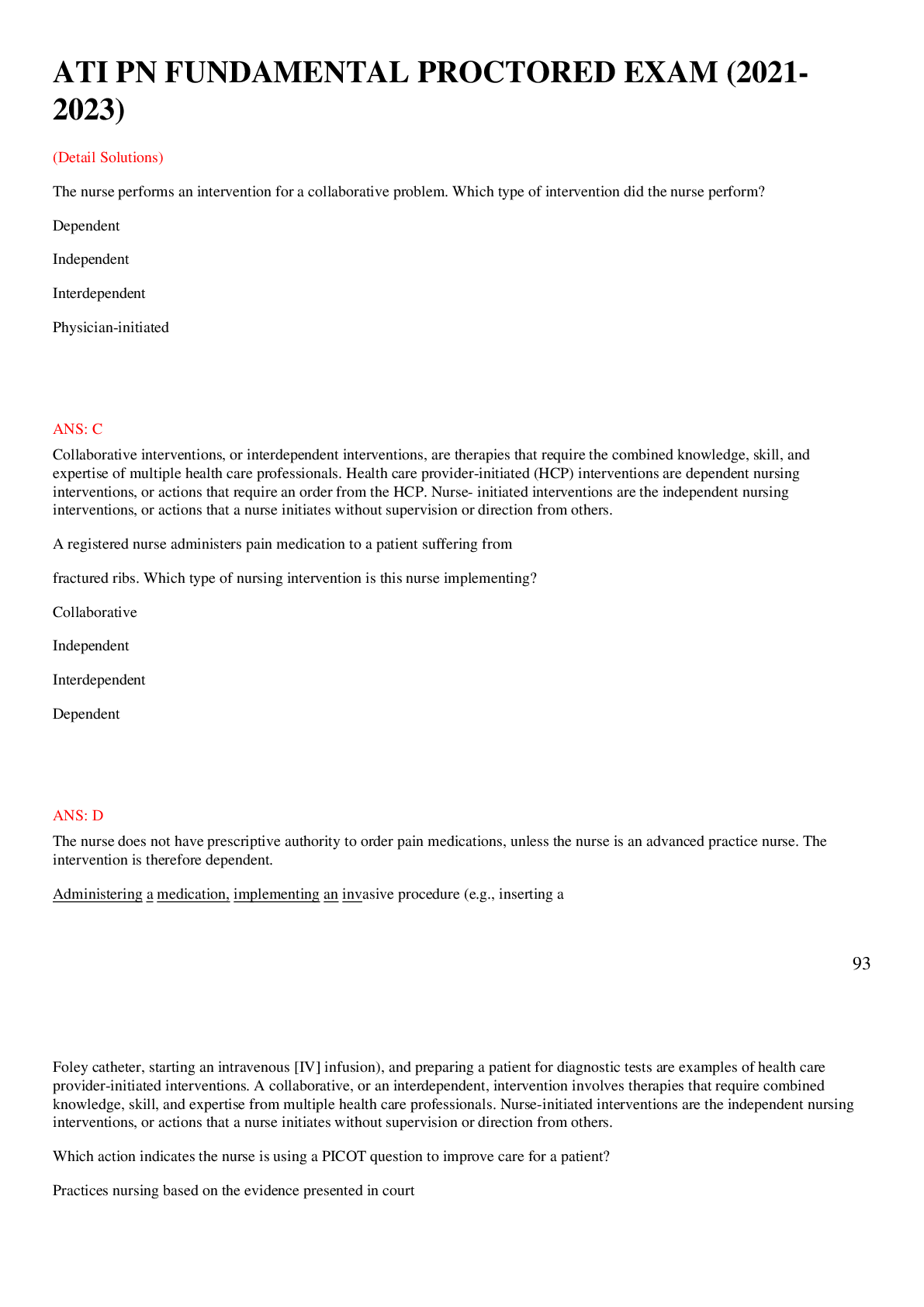
Reviews( 0 )
Document information
Connected school, study & course
About the document
Uploaded On
Jul 21, 2022
Number of pages
28
Written in
Additional information
This document has been written for:
Uploaded
Jul 21, 2022
Downloads
0
Views
40


.png)







